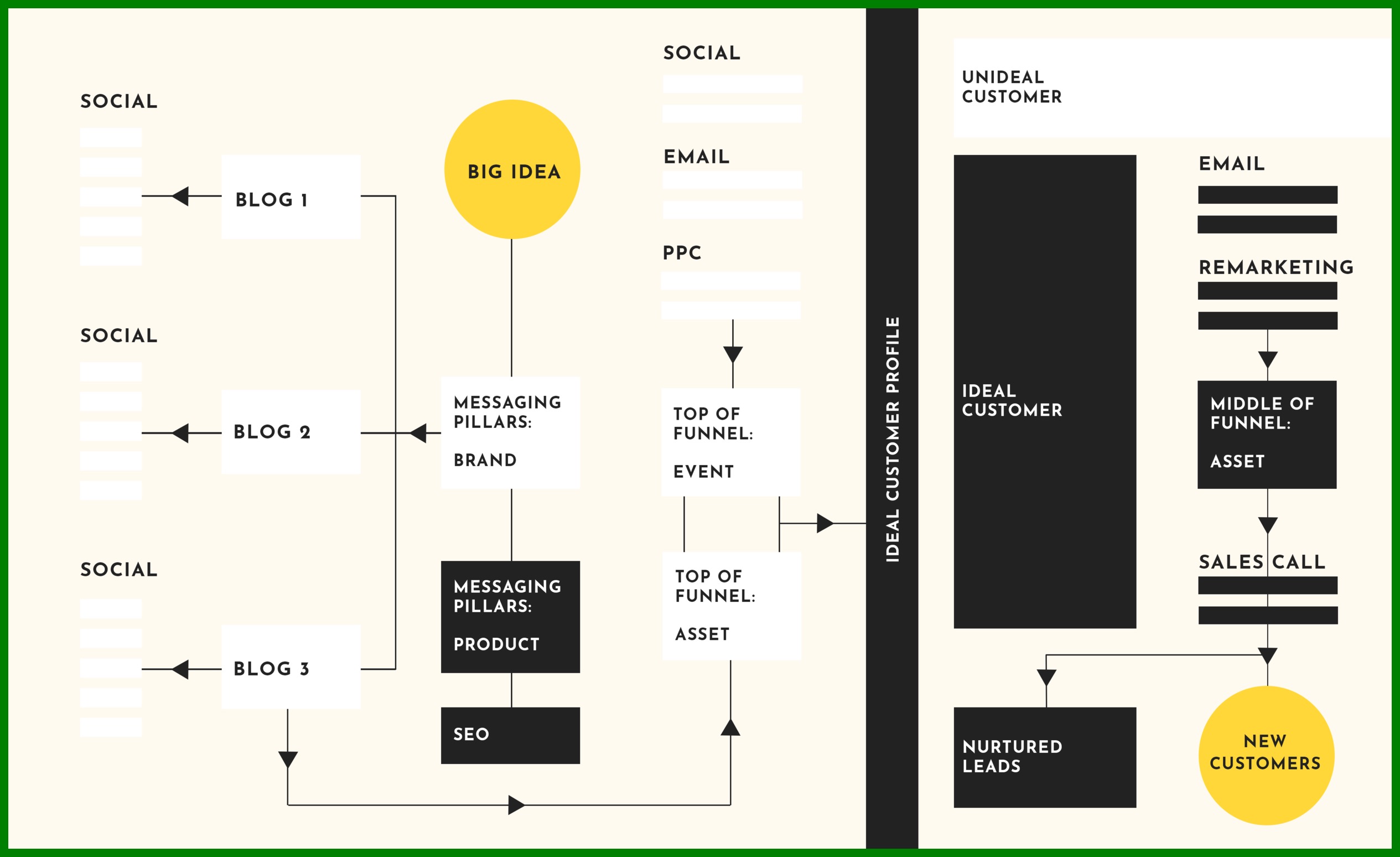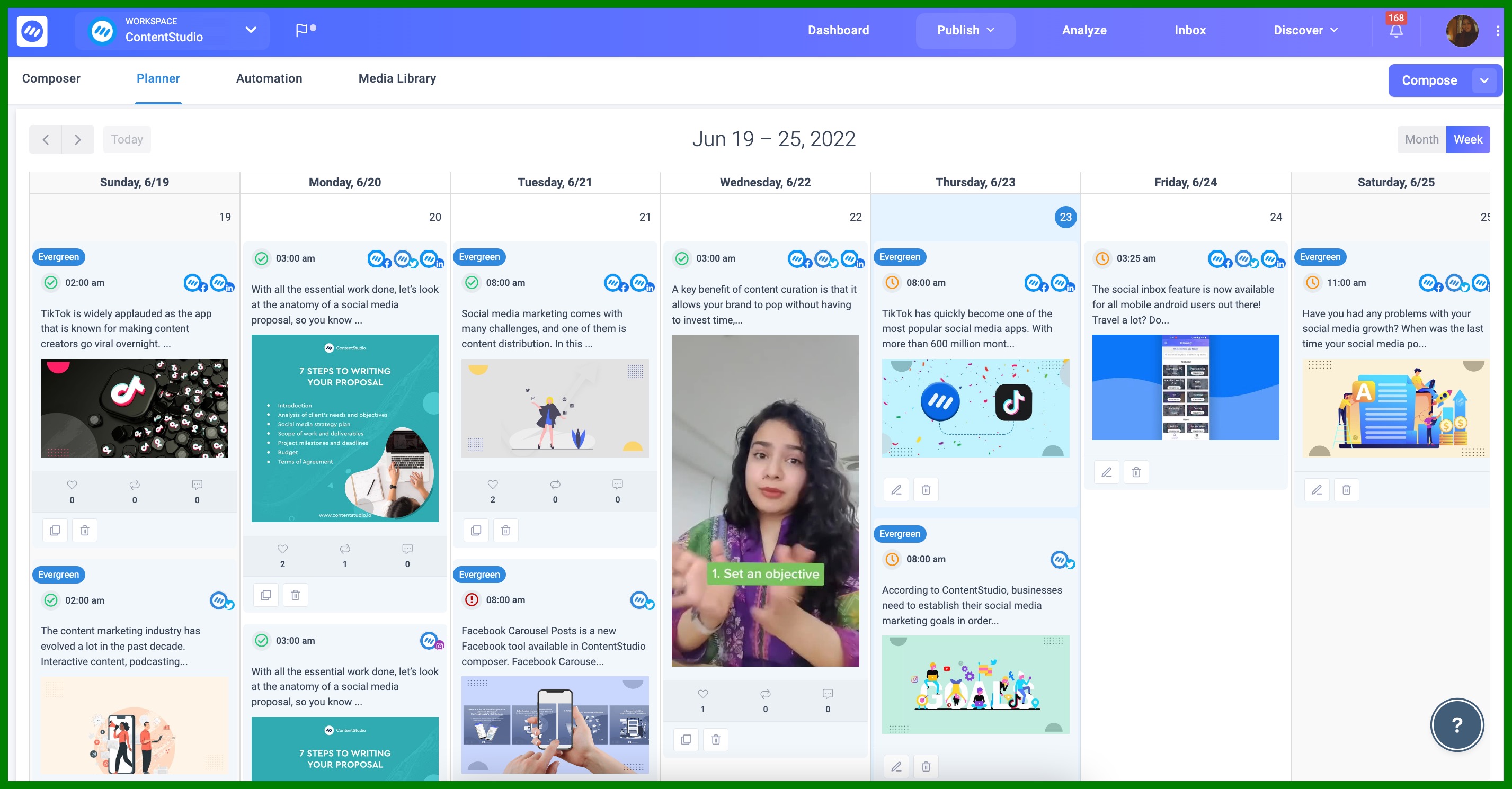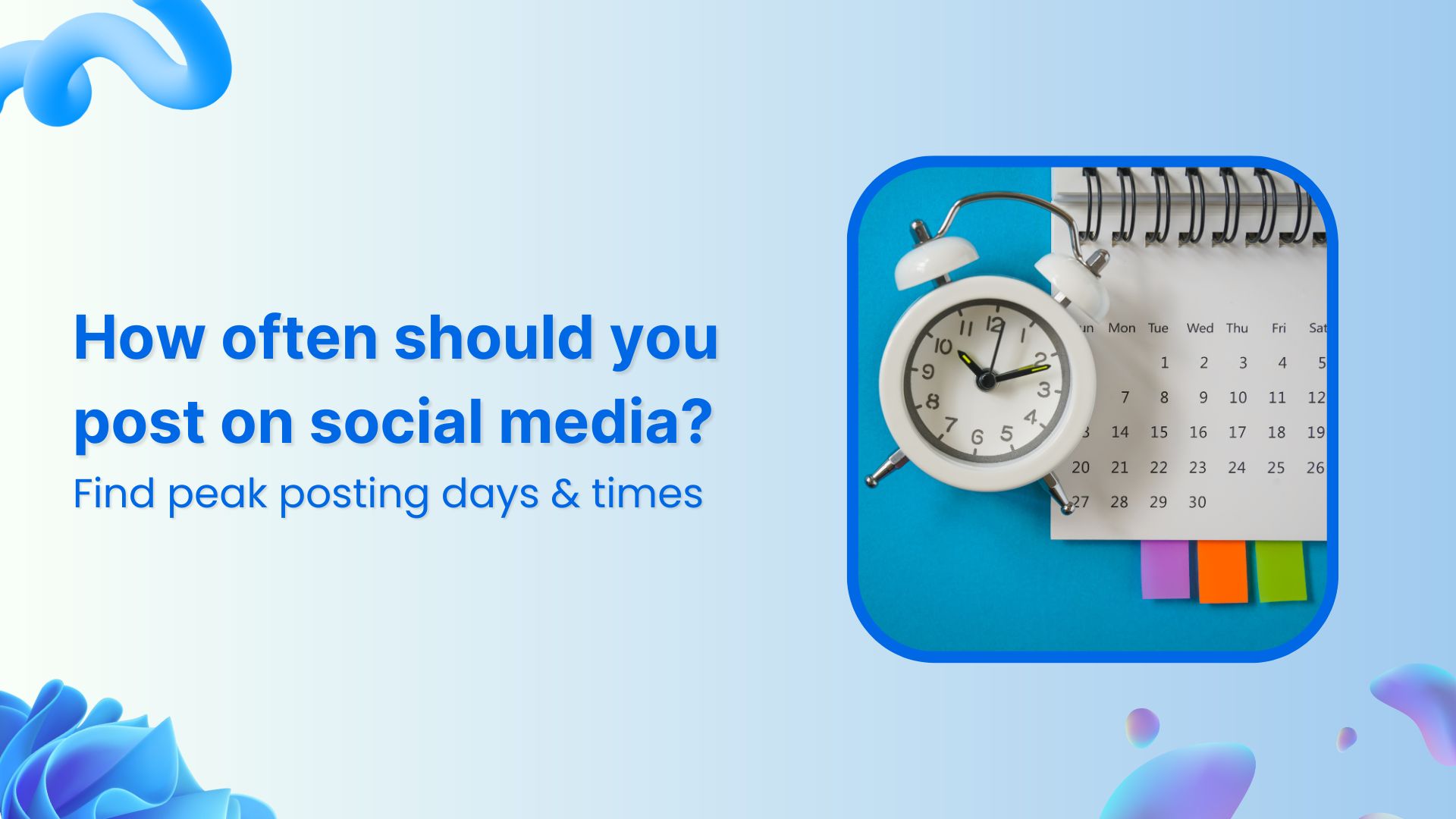Do you think your social media content strategy is lacking even after some coffee and brainstorming sessions?
It’s possible you haven’t started with mapping your ideas on paper. Perhaps you forgot to factor in the prevailing social media trends. And did you audit your networks’ past performance?
A lot of work goes into planning a social media content strategy. So, a hailstorm of questions that I’m asking might confuse you. However, if you start smart and take strategic steps, you’d find yourself in a happier place with a ready-to-execute social media strategy by your side.
So how should you start? This post outlines exactly what you need to do to draft a social media content strategy.
Let’s dig in. Shall we?
Preface (Things to notice before scrolling ahead)
Start with Setting Goals
As with any other plan, start with outlining your goals for social media. What do you want to achieve this year with social? Do you aim to maximize brand awareness, or are you planning to boost conversions?
The right way to set your goals depends on what you’ve achieved on your social channels so far.
For instance, if you’re only getting started, you might want to focus on increasing brand awareness and developing authority in your field. So, boost your engagement and build relations with your target audience. At least for a quarter. Then go on to tweak your goals.
If you’ve been around social for some time, you can set different goals, such as maximizing conversions via social media or polishing your social listening strategy. Either way, grab a paper (or open a document) and write those goals down.
Flesh Out the Details
Here comes the part where you squint your eyes and think clearly. How will you achieve the goals that you’ve just set?
Start with a social media audit. Study your social media profiles and see how well you performed. The key here is to get the answers to the following:
⦁ Which of your social networks did well in 2021? Why do you think others didn’t deliver?
⦁ Which content performed the best, and what fell flat?
⦁ Did you organize any campaigns? For example, did you plan giveaways or participate in Twitter chats? How well did it all work out in the end?
Once your analytics answer these for you, start deciding what works or doesn’t. And answer the why’s. Then, either work out how to improve your previous strategies or eliminate them from your plan if they don’t work.
Lay Out Your Social Media Content Strategy Plan
By this point, you will have a good idea of what you need to do as part of your social media strategy. Next step? Start dumping your thoughts on paper. Or use a whiteboard and start brainstorming. All the plans you’ve in mind for your social media go over here. Make sure you put your goal on top of this paper/board so you don’t deviate from it.
On one side, list what tactics you plan to continue implementing from 2021. On the other side, jot down your lessons, such as why something didn’t work or your significant takeaways from a planned holiday campaign.
Use the rest of the space to dump your ideas. Here’s what you can do:
⦁ Take inspiration from others in your industry
⦁ Or try out what you saw someone else doing outside your industry to introduce something new
⦁ Ask your audience what they’d like to see more from you
Keep Yourself Focused
When trying to stay focused, having a specific goal in mind can be helpful. First, clearly define what you want to achieve, then break down the steps you need to take to get there. Creating a plan will help you stay on track and avoid getting sidetracked by distractions.
Getting caught up daily and losing sight of your goals is easy. But if you keep yourself focused on what you want to achieve, you’ll be more likely to reach your destination.
What’s more, you need to consider social media trends for the current year. So let’s walk you through some tactics to consider as you create your social media content strategy:
How to Craft a Social Media Content Strategy Framework
Social media has become an essential part of any content marketing strategy. Not only does it provide a way to connect with potential customers, but it also allows businesses to share their stories and build relationships with their audience. However, before you can start reaping the benefits of social media, you need to craft a content strategy.
If you’re like most businesses, you know you need to be on social media, but you may not have a clear strategy for what you should post or when. That’s where a content calendar comes in. A content calendar is a tool that helps you plan and schedule your social media posts in advance. This way, you can make sure you’re always posting fresh, relevant content that your audience will engage with.
This process can seem daunting, but by following a few simple steps, you can develop a framework that will guide your social media efforts.
Roll Your Mind, Write down Everything
Writing an article isn’t something that can be accomplished within minutes. But if you have prepared yourself for what to write, then there is a possibility of executing it in just a few short hours because your ideas are clear on paper and ready to go! The same applies when creating content marketing strategies; we don’t want any time wasted looking at unnecessary stuff – so make sure everything necessary has been considered before moving forward with this step.
Ask these questions to yourself and then write down the answers:
- Who is the target audience?
- Why do we need to create the content?
- What sort of content shall we generate?
- How would that content help us accomplish our goals?
- Finally, what outcome shall we expect?
The more questions you ask yourself, your next state will be better. Before planning something, always brainstorm and set a target, then focus on it until we achieve that goal!
Clarify Your Goals
When pursuing your goals, you must be clear about what you want to achieve. This can help you stay focused and motivated as you work towards reaching your goals. So take some time to sit down and really think about what you want to achieve.
What are your long-term goals?
- What are your short-term goals?
- What steps do you need to take to reach those goals?
Once you clearly understand your goals, you’ll be one step closer to achieving them. For instance, Look at the Long Tail Pro’s website. They’ve written a questioning statement above the fold, “Are You Looking for an Easy Way to Find the Best Keywords to Rank in Google?” It shows that they’re crystal clear about their prospective audience and expect people who need keywords to rank on Google to visit their website.



Related: 10 Social Media Goals For Marketers [+Tips To Achieve Them]
Map out the Content Strategy
What is content marketing? It’s not just about creating great blog posts, but instead, it’s an entire strategic approach to building your business by leveraging high-quality information.
For this strategy to work effectively, there needs to be a plan that identifies who you’re targeting, intending to engage them and get them interested enough, so they’ll come back later when new content has been published or old links re-surfaced. Then, once these people are engaged, we should follow up consistently until conversion occurs – either through lead generation (prospecting) if our audience isn’t yet big enough or engagement from regular visitors.
In short, Content strategy is crucial in the world of digital marketing. It helps to identify your audience, establish goals for what you want them to achieve through content marketing, and then put it all together into one cohesive plan that will work towards lead generation and conversion opportunities!



Related: How to Build an Effective Social Media Strategy in 2022
Do a Content Audit
We all know content is king, but how do you take the right approach to build your marketing arsenal?
One way may be by conducting an audit on what kind of information has been created so far. This will allow for comparison and evaluation between past efforts and help identify opportunities in new areas where resources could potentially yield better results!
Here we take ContentStudio’s content inventory example; There are two sides to it; offsite and onsite.
Offsite
- Its Social Media Accounts
- The Mailing List Of Subscribers
- Guests Posts (perhaps for backlinking)
Onsite
- ContentStudio Help Center
- ContentStudio Blog
The deeper you’ll get into it, the more information you’ll receive about the marketing content stuff that you need to have first in your inventory.
- You will get all the keywords that you’re ranking in the search engines
- You will get your top blog posts with the highest receiving traffic
- The email list
- All the live web pages and so on.
The question might come to your mind how would you do the content audit?
You don’t need to worry about it! Many valuable tools could help you evaluate the marketing content and how things are going well for your business, such as SEMrush or Moz.



Related: How To Conduct A Successful Social Media Audit
Incorporate stories if you already haven’t
This is your wake-up call for using stories on social if you already don’t. Both Facebook and Instagram boast many users who watch stories, with 500 million daily Facebook story users (2019) and 400 million Instagram daily story users (2018). No wonder stories are among the leading trends of this year.
Use these stories to share behind-the-scenes content, promote time-sensitive discounts, promos, giveaways, and deals, share user-generated content, and more.
Work more on video content.
In case you’ve missed this – video marketing is immense. Brands like The Goulet Pen Company have grown with a solid video content strategy. But does this mean you need to start a YouTube channel? Nope.
You can always create and upload videos to other social channels. And, you also don’t need to worry about what content to cover. Simply repurpose your blog posts, and you’re all set. Or record interviews like the Founder of TrackMaven, Allen Gannett, does.



Rethink the social networks you use
There’s more to the social horizon this year, with networks like Snapchat and TikTok growing at breakneck speed.
In March 2019, Snapchat reached 75% of the US’s 13-34 age bracket. But that’s not all. The photo giant reached 90% (!) of all the 13-24 in the country. TikTok, on the other hand, gets 41% of teens and young adults within the age range of 16-24 throughout the world.
But jumping onto both these networks isn’t what we’re suggesting. Instead, thinking if joining TikTok or Snapchat is worth it for your social media content strategy 2020 should be your goal.
Decide by:
⦁ Determining if your target audience uses these platforms
⦁ Understanding what is prevailing in your industry/niche
⦁ Learning from examples – will follow so and so tactic work for your brand?
UGC is spiking
User-generated content (UGC) is authentic. It contributes to social proof, helping you convince leads to turn into prospects. Besides, adding it to your social media content strategy also means you’re better at engaging with your existing customers.
You should plan a campaign around it like WayFair does:


Pair up with authentic influencers only
Influencer marketing has been trending for a long. But there’s a subtle shift in focus here.
Don’t collaborate with any influencer. Instead, aim to work with micro-influencers in your niche. These are people with small but engaged communities in social spaces that your audience is more likely to trust than an influencer who promotes anything.
The Senior Social Media Manager at KoMarketing Associates, Anastasia Warren, advises, “Look into industry event speakers or ambassadors to see who your target audience is paying attention to on social media and on the floor at industry events.”
Reach out to them and collaborate away!
Promote and Distribute your content
To create a successful social media strategy, you need to find ways of getting your content out there. To promote your content, start by distributing it across different channels. This will help get your content in front of more eyes and potential customers. Also, don’t forget to include a call-to-action in your content, so people know what you want them to do next. Lastly, regular promoting and hustling are crucial to getting your content seen by as many people as possible. So keep at it!”
There are numerous tools like ContentStudio, which let bloggers manage multiple accounts from one dashboard, compose content, schedule for various social channels, and manage their marketing activity under a single shelter.
The best time to post on social media is when your audience already knows about the content. They’re online and ready for it! By recognizing this, you can reach more people with each share of a timely post than if you only posted at random intervals throughout an entire day or week without paying attention as trends happen around us constantly in real-time like newsfeed updates do these days (or ever).



Related: Create a Winning Social Media Content Calendar in 2022
Other Factors to Think About as You Plan Your Social Media Content Strategy
Let’s take a break here and recap – you start with setting your goals and outlining steps to reach those goals. A social audit will give you a picture of what has worked and what hasn’t so far so you can alter your plan accordingly. Then, you see what’s hot and decide trends you’d like to pursue.
But that’s more. Before we talk about the next steps, you need to pay attention to the following two aspects:
1. Social media posting time
If you’re new to social for your business, you might want to check out the available research on the best times to post on different social channels. Keep testing which timings get you the most engagement to learn when your audience is most active on social.
On the flip side, if you’ve been around social for some time, tally the times your audience was most active from last year’s analytics and plan posting times accordingly.
2. Social media posting frequency:
Alongside deciding when you need to post, also question how often you should post. Posting infrequently can make you easy to forget. It drops your engagement too. As in the previous case, check out what the latest studies say about posting frequency if you are new. Or, decide what suits you according to your audit results.
3. Your brand voice:
Lastly, ask yourself – does your social media content strategy align with your brand voice? Did the posts that didn’t do well on social failed because they didn’t reflect your voice? Whatever you plan, make sure it reflects your voice. Having a consistent brand voice is a surefire way to win your audience’s heart.
My favorite example of brand voices is Innocent Drinks. They don’t necessarily talk about their products in each post. But they have a distinct voice that reminds me of them every time I come across their social content.
FRIDAY TO DO LIST:
1. Think about the weekend
2. Think about doing some work
3. Think about the weekend a bit more
4. Repeat until 17:30
5. Realise you haven't done any work
6. Panic
7. Take a deep breath
8. Decide it can wait till Monday— innocent drinks (@innocent) February 7, 2020
Putting it all together, we have the following three points:
⦁ Plan unique content that aligns with your brand voice
⦁ Aim to post consistently and when your audience is most active
⦁ Decide how many posts you’d make on each of the social networks you use
Build a Social Media Calendar
By this point, we’ve talked about auditing your social accounts and introduced important social media trends worth trying. What’s next? Visualize your plan with a social media content calendar.
At the end of the first step, you’ll have planned your next moves. Now put those down in a calendar. You can always build a social media calendar. But you’ll only waste your time considering you can fetch a template and customize it as per your needs.
Either way, the goal is to plan your social content according to holidays and events popping throughout the year. You could plan a discount around Mother’s Day or you could create a hashtag around the holiday season.
Here’s an idea – Melanie Deziel, content marketer and author of The Content Fuel Framework hosted a book giveaway around the Random Acts of Kindness Day on Feb 17:
I’m celebrating #RandomActsOfKindnessDay with a book giveaway, but I need your help.
Tag someone you think should get a signed copy of “The Content Fuel Framework” and share why.
We’ll pick a few winners tonight! pic.twitter.com/x3vq7SjG5q
— Melanie Deziel ♥️???????????? (@mdeziel) February 17, 2020
Once you have your plans in the calendar, you’ll have a visual idea of how your social is going to look for 2020.
Remember, you don’t need to complete it down to the bones today. But you need a master plan before you go about planning social media content on a quarterly basis. Put simply, sketch out a skeleton for your social media content strategy for 2020. Then flesh out the skeleton on a quarterly basis.
Pro-tip: consider using a project management platform to help you better plan your strategy using a content calendar tool and stay on top of things.
Next off – make yourself an engagement plan.



Social Media Calendar for Digital Agencies
Organize all your social posts and visualize your client’s social media content plan with an interactive Content Calendar
14 days free trial - no credit card requiredHighlight Your Step to Grow Engagement
I can bet your social media won’t go anywhere even if you’ve high-quality visuals and a good copywriter by your side. Why? Glad you asked. Because there’s no better way to get into your audience’s radar than by engaging with them.
An old study also confirms this. According to it, over 30% of people unfollow a brand if they get an automated message. And, 45% unfollow if they see a lot of self-promotion.
Don’t sweat though. Engagement can save your day. An active presence on social media tells users you’re available to chat or solve a query they may have. Your presence (and subsequent engagement) also shows your business’s human side. Hence, your odds of getting into your followers’ negative light go down.
So it makes sense you need a plan to engage by your side, right? Note it down and then make a checklist of what you need to do on a daily or weekly basis. The rest of your social posts can go out with the help of a social media automation tool (hint: ContentStudio can help).
Here are some social media engagement tactics to add to your plan:
1. Post engaging content
Our brains love stories. Tell them. Take Dunkin Donuts for example:



Another tip – ask questions. Share an experience or a lesson you learned, and then ask your audience to share their thoughts on it.
Lastly, post-behind-the-scenes content on social. Again, this type of content shows your brand’s human side, which works wonders in attracting like-minded people.
2. Focus on the community-building aspect of social
Another great way to engage with your audience is by joining communities relevant to your field. In 2020, the focus on private conversations is only going to deepen. In fact, Facebook’s Co-founder and CEO, Mark Zuckerberg has been pretty clear about it, “the future is private.”
You have two ways of moving forward. Either join communities or make one yourself. Here’s how:
⦁ Join Twitter chats
These are (typically) hour-long conversations between like-minded people who discuss a select topic by answering questions that a host tweets. Participants are free to join in using a specific hashtag.
For instance, social media enthusiasts group together virtually to discuss social topics (including trends, time-tested strategies, and latest news) with their host Social Media Examiner on Wednesdays at 1pm ET/10am PT. All participants used the #SMEchat tag.
You can jump into Twitter chats in your field. Find out chats relevant to you here.
You can also host your own Twitter chat. A case in point is Green Rope, a CRM company that has recently launched its #CoolerChat.
⦁ Join social groups
One of the best ways to engage with your niche audience on Facebook and LinkedIn is by joining groups or creating one. Again, be sure to join only groups where your audience is or create a niche-specific group. Either way, start by engaging and offering value in the group.
For instance, a B2B agency, Skotidas created and grew its LinkedIn group, Social Media Lead Generation, which has become a source of consistent leads for them.
⦁ Create a hashtag that unites people
Lastly, you can also unite people using a hashtag. A word of caution though – not everyone can pull this off. Your product or service needs to be phenomenal, of course. It’s only then that people will post about it on social.
A case in point is Trello engaging with their customers and encouraging lots of user generated content with their WhereITrello hashtag.
Outline an Action Plan for Tracking Results
Last but an important aspect of developing a social media content strategy is deciding which social media key performance indicators (KPIs) you need to track and how often.
Ideally, keep away from vanity metrics like follower count and keep tabs on engagement-related indicators like comments and shares. Some worthy KPIs to measure are:
⦁ Comments
⦁ Likes and shares
⦁ Brand mentions
⦁ Clicks
Don’t forget to decide when you’d check your metrics – monthly, quarterly, etc.
Wrapping up
Are you ready to rock your social media content strategy? Hopefully, with this post, you’ve an action plan moving forward. If you still have any questions, feel free to ask them in the comments.
Masooma Memon
Masooma Memon is a pizza-loving freelance writer by day and a novel nerd by night. She crafts research-backed blog posts and articles for small businesses and app companies who aim to employ quality content to educate and engage with their audience.








